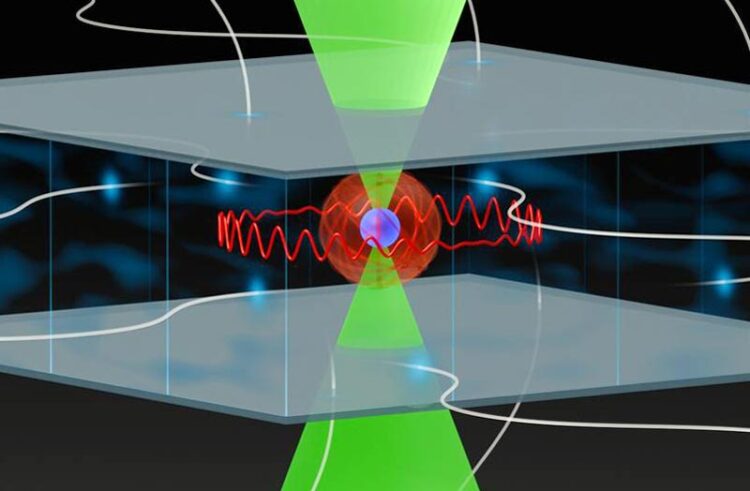Milestone in quantum simulation with circular Rydberg qubits

Illustration of a circular strontium Rydberg atom trapped in optical tweezers
Photo: University of Stuttgart, Aaron Götzelmann
A team of researchers from the 5th Institute of Physics at the University of Stuttgart is making important progress in the field of quantum simulation and quantum computing based on Rydberg atoms by overcoming a fundamental limitation: the limited lifetime of Rydberg atoms. Circular Rydberg states are showing enormous potential for overcoming this limitation. The renowned journal Physical Review X reports on this in its latest issue.
In the world of quantum computing and quantum simulation technology, there is a fundamental challenge when using neutral atoms: The lifetime of Rydberg atoms, which are the building blocks for quantum computing, is limited. But there is a promising solution: circular Rydberg states. For the first time, the research team has succeeded in generating and capturing circular Rydberg atoms of an alkaline-earth metal in an array of optical tweezers. “This is exciting because they are particularly stable and can extend the lifetime of a quantum bit enormously. They therefore have great potential for the development of more powerful quantum simulators,” says Dr. Florian Meinert, Head of the Junior Research Group at the 5th Institute of Physics, who is in charge of the project.
The significance of circular Rydberg atoms
A circular Rydberg atom is a particular type of Rydberg atom in which the excited electron follows a circular path around the atomic nucleus. Compared to other Rydberg states, these atoms have an increased stability and a longer lifetime. This makes them attractive candidates for use as qubits. Circular Rydberg states have been known for decades and were the key to Nobel Prize-winning experiments on the quantum nature of light-matter interaction. Recently, the potential of these states for quantum computing has been increasingly discussed again.
Promising: Strontium, an alkaline-earth metal
Strontium, an alkaline-earth metal with two optically active electrons, was chosen to create the Rydberg atom since it offers unique possibilities. Once prepared in the circular Rydberg state, the second electron orbiting the atomic nucleus can be used for quantum operations that are already known from research on ion quantum computers. The research team demonstrated the generation of very high-energy circular states of a strontium isotope with an astonishingly long lifetime of up to 2.55 milliseconds at room temperature. They made use of the special properties of a cavity that suppresses the interfering blackbody background radiation, which would drive the sensitive Rydberg electron into other energetically neighboring Rydberg levels. Without this shielding, the circular states would not be able to survive for long. “They also owe their longer lifetime to their maximum angular momentum, which protects them from decay. This means that the quantum bits are more stable and therefore less susceptible to errors and external interference,” explains Christian Hölzl, PhD student at the 5th Institute of Physics.
Quantum bits under control
Another important aspect of the research was the precise control and manipulation of a microwave quantum bit encoded in circular states. This so-called coherent control enabled the scientists to use microwave pulses to switch the qubit between different states without losing its quantum information. They were able to precisely determine the lifetime of the quantum bit and gain important insights into its stability at room temperature. Effective coherent control is crucial for performing quantum operations and makes them precise and reliable.
A wide range of applications
Circular Rydberg atoms offer a multitude of possibilities for performing quantum operations and, in particular, quantum simulations. “Their versatility makes them attractive for a wide range of applications,” says Prof. Tilman Pfau, Director of the 5th Institute of Physics and the supraregional Carl Zeiss Foundation Center for Quantum Photonics – Jena – Stuttgart – Ulm (CZS Center QPhoton). Since circular Rydberg atoms can be specifically trapped and precisely manipulated in optical tweezers or other types of traps, they offer possibilities for a scalable architecture that could be advantageous in the future for building large quantum bit systems based on neutral atoms.
About the project
The project, under the leadership of Florian Meinert, has been funded since 2021 by the Federal Ministry of Education and Research (BMBF) as part of the “Quantum Futur” initiative to support young talent, with a project duration of five years and a project volume of EUR 2.6 million.
Publication: Christian Hölzl, Aaron Götzelmann, Einius Pultinevicius, Moritz Wirth, Florian Meinert: Long-Lived Circular Rydberg Qubits of Alkaline-Earth Atoms in Optical Tweezers, Phys. Rev. X 14 (2024), DOI 10.1103/PhysRevX.14.021024, Physical Review X.
Further information: the Quantum Länd.
Expert Contact:
Dr. Florian Meinert, UUniversity of Stuttgart, 5th Institute of Physics, phone: +49 711 685 67893, email
Media Contact
All latest news from the category: Physics and Astronomy
This area deals with the fundamental laws and building blocks of nature and how they interact, the properties and the behavior of matter, and research into space and time and their structures.
innovations-report provides in-depth reports and articles on subjects such as astrophysics, laser technologies, nuclear, quantum, particle and solid-state physics, nanotechnologies, planetary research and findings (Mars, Venus) and developments related to the Hubble Telescope.
Newest articles

Detector for continuously monitoring toxic gases
The material could be made as a thin coating to analyze air quality in industrial or home settings over time. Most systems used to detect toxic gases in industrial or…

On the way for an active agent against hepatitis E
In order to infect an organ, viruses need the help of the host cells. “An effective approach is therefore to identify targets in the host that can be manipulated by…

A second chance for new antibiotic agent
Significant attempts 20 years ago… The study focused on the protein peptide deformylase (PDF). Involved in protein maturation processes in cells, PDF is essential for the survival of bacteria. However,…





















